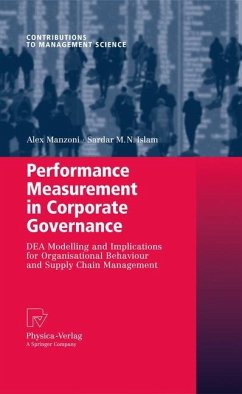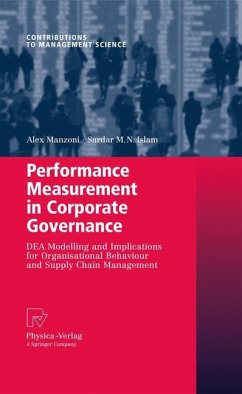
Equity Ownership and Performance
An Empirical Study of German Traded Companies

PAYBACK Punkte
38 °P sammeln!
The basis of all corporate governance considerations is the effect of ownership structure on company performance. While the effects of ownership structure were hypothesized and studied multiple times, previous analyses neglected the endogeneity issue between ownership and performance as well as between different ownership dimensions themselves. Consequently, they failed to yield consistent results.
The empirical studies presented in this book model the endogeneity by applying the simultaneous equations methodology on the relation of ownership and financial performance as well as on different ownership dimensions themselves. Its final model comprises a four equations system containing performance, general ownership concentration, managerial and institutional ownership.
This approach allows more precise findings and is capable of tracing the different observed ownership effects back to their real origin, which will give much impetus to corporate governance researchers and practitioners.
The empirical studies presented in this book model the endogeneity by applying the simultaneous equations methodology on the relation of ownership and financial performance as well as on different ownership dimensions themselves. Its final model comprises a four equations system containing performance, general ownership concentration, managerial and institutional ownership.
This approach allows more precise findings and is capable of tracing the different observed ownership effects back to their real origin, which will give much impetus to corporate governance researchers and practitioners.
Corporate governance has been at the center of interest in the corporate- nance literature for the past decade. The discussion has continuously int- si?ed due to the occurrence of multiple corporate governance failures which have triggered the introduction or further re?nement of national and inter- tional corporate governance codes. The necessity of regulatory action however rests on the need for a sound understanding of potentially negative e?ects of ownership structure on ?nancial performance. Unfortunately, the empirical literature so far has not delivered consistent evidence leaving the overall e?ects still somewhat in the open. This incons- tency is argued to stem from di?erent biases in the statistical analysis, where the most important ones are the endogeneity and simultaneity bias. The - jective of this dissertation is to provide less distorted results by modelling various ownership aspects and performance simultaneously. The study sets out with a simultaneous equations analysis of the re- tionship between general ownership concentration and performance. This is followed by an examination of more speci?c ownership e?ects with a foll- up model focusing on managerial ownership and another one on institutional ownership. Subsequently, the author combines the three previous models in a ?nal comprehensive analysis which allows for the simultaneous assessment and separation of the di?erent ownership and performance e?ects. Withitsstate-of-the-artanalysis,thedissertationcontributessubstantially to the existing international empirical literature on the relationship between corporate ownership and performance. I wish for this dissertation to give impetus to and become widely accepted by corporate governance researchers and practitioners alike.














